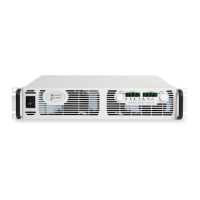2 Installation
30 Series N8700 User’s Guide
NOTE
If the power supply is operated without the local sense jumpers or without the
remote sense lines connected, it will continue to work, but the output voltage
regulation will be degraded. Also, the OVP circuit may activate and shut down
the power supply. Note that the internal wiring between +V and + local sense
and between –V and – local sense will fail if load current flows through it.
Remote Sensing
Use remote sensing in applications where load regulation at the load
is critical. Remote sensing allows the power supply to automatically
compensate for the voltage drop in the load leads. Refer to Appendix
A for the maximum allowable voltage drop on the load wires.
Remote sensing is especially useful in constant voltage mode with
load impedances that vary or have significant lead resistance. It has
no effect in constant current mode. Because sensing is independent
of other power supply functions it can be used regardless of how the
power supply is programmed. With remote sensing, voltage readback
monitors the load voltage at the remote sense points.
Use twisted or shielded wires to minimize noise pick-up. If shielded
wires are used, the shield should be connected to the ground at one
point, either at the power supply chassis or the load ground. The
optimal point for the shield ground should be determined by
experimentation.
To configure the power supply for remote sensing:
Turn off the power supply.
Remove the local sense jumpers from the J2 connector.
Connect the negative sense lead to terminal 5 (-S) and the
positive sense lead to terminal 1 (+S). Make sure that the
connector plug is securely inserted into the connector body.
Turn on the power supply.
-
-
Rem.sense
Local sense
ocal sense
Rem.sense
+L
+
Sense lines.
Twisted pair or
+V
-V
Load
+
Power
Supply
Load lines. Twisted pair
shortest length possible.
shielded wires.

